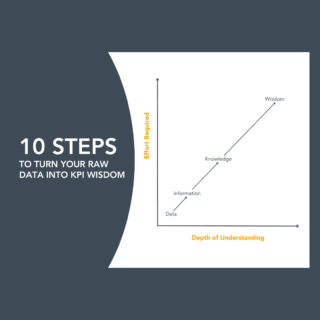I have never met a leader who doesn’t believe that their teams should be accountable for achieving their goals. Yet, when asked who owns the performance measures associated with the goals, there is often a troubling silence.
The highest quality, most meaningful performance measure in the world can be rendered utterly useless if no one is clear about who should interpret and use it during strategy execution.
What happens when KPI ownership is vague?
In the best of times, measures are used as feedback loops that link strategy execution to the achievement of the strategic plan; and executives need to lead these conversations. Unfortunately, in organizations where measures have no clear ownership or are owned by committees, you’ll observe the following:
• Debates about what the measure is saying, whether performance is improving, worsening or staying the same
• Circular discussions about whether the measure’s data is trustworthy or even relevant
• Performance measurement discussions falling to the bottom of the agenda or off the agenda all together
• Performance measures that never seem to have data.
The root cause of these dysfunctions is that KPI ownership has never been clearly defined or described.
What does it mean to own a KPI?
Lisa Wilms of InfoTrust defines what it means to own something in a business context in the following way:
• Ownership is taking the initiative to bring about positive results. It means not waiting for others to act, and it means caring about the outcome as much as an owner of the company would.
• It is being accountable for the results of your actions. That the results are of the highest quality and delivered in a timely manner
• Taking ownership shows others that they can trust you to do the right thing.
When we deliberately bring a performance measure (KPI) into the world, we must want the same things as Lisa describes:
• The owner wants to achieve positive results, by using a KPI that has data of the highest quality that drives taking timely action from the insights.
• Leaders trust the owner to develop a meaningful measure that is not trivial and where the data will not be gamed.
• Owners want to do the right thing and feel safe having honest conversations, even when performance is not improving.
What are the different types of KPI owners?
For leaders to make evidence-based decisions, they need more than just one role when bringing the measure’s insights to life:
• Role 1: Defining exactly how the measure should be calculated and implemented
• Role 2: Implementing the measure so it gets consistently calculated and reported
• Role 3: Using the measure to improve performance and achieve our results
Each of these roles requires different responsibilities, different skill sets and different authorities.
Role 1: The Performance Owner
The performance owner tracks the measure’s progress, understands what is causing the changes in performance, and has the authority to initiate action. Often, performance owners are department leaders, managers, team supervisors, or project leads. Most importantly, this owner has the know-how to interpret the measure and lead improvement so the performance gap is closed.
Role 2: The Definition Owner
The definition owner coordinates the creation of the measure and manages the KPI’s definition so it reflects the needs of the performance owner and the organization. Often the definition owner will be someone very comfortable speaking the language of data, calculations and measures. They might be business analysts, data scientists, process or performance improvement specialists, or measurement professionals.
Role 3: The Reporting Owner
The reporting owner works closely with the definition and performance owners to ensure the measure is accurately included in appropriate performance reports or dashboards. Sometimes reporting owners and definition owners are the same people; or, it might more naturally fall to whomever is responsible for getting the routine performance reports or dashboards published each month or quarter. Reporting owners must ensure that the audience can quickly and easily answer the question “What is performance doing? Is it improving over time or not?”
Role 4: The data owner (sometimes)
Data owners are the managers, creators or collectors of the sources of data required for the measure. For any single measure there might be several data owners, depending on how many sources of data the measure’s calculation calls for. They need to understand how the measure is going to be calculated and used, so they can appreciate just how important their data is. Data owners often work with an organization’s information systems, particularly for data that is captured automatically. Data owners can also be in operational roles that require them to be involved in manual collection and collation of data.
Use these 3 critical steps to improve the ownership of KPIs
Step 1: Define Accountability in a culture of learning
Unfortunately, in most workplaces, performance measures are used to judge (creating fear, anger and anxiety) making ownership trickier than in many other business situations. To improve KPI ownership, the definition of accountability must be grounded in a culture of learning that drives continuous improvement.
Step 2: Start with the End-in-Mind so ownership is for both the goal and the measure
Unfortunately, most organization’s KPIs are not clearly relevant or connected to the leaders’ goals in their strategic plan. This makes it hard to own both the goal and the measure, which is what is needed for successful strategy execution. To meaningfully keep the end in mind, organizations must be committed to developing shared understanding and unpacking fuzzy language goals into clear, plain language result statements. Only then can the measure be designed to provide evidence of the goal.
Step 3: Help Leaders be courageous in owning measures
No single person or team has complete control over a goal or result’s performance; but improving performance does require them to have honest conversations about why performance is not improving and what might be the root cause so they can close critical performance gaps. We need to combine Step 1 with the understanding that collaboration not blame, is what fixes problems and closes gaps during strategy execution.
To ensure your KPI’s provide value to your organization (rather than dying a slow death by being avoided), give clear, specific and well-defined ownership to those who are driven to monitor, interpret and improve the performance of the goal the measure tracks.
The PuMP® Performance Measure Blueprint was created by Australia’s performance measure specialist Stacey Barr. Louise Watson of Adura Strategy is Canada’s Official Partner and Licensed PuMP® Blueprint consultant.



